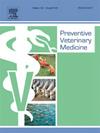马来西亚半岛巴生谷自由漫游狗的数量和密度:一种改进管理和狂犬病控制的比较枚举方法
IF 2.4
2区 农林科学
Q1 VETERINARY SCIENCES
引用次数: 0
摘要
管理自由漫游的狗群是一个关键的全球公共卫生问题,特别是在城市环境中。准确的人口估计对于设计有效的管理和狂犬病控制战略至关重要。本研究旨在利用基于摄影视力法的多重分析模型估计马来西亚半岛巴生谷的自由漫游犬种群。数据包括GPS位置、所有权状态、年龄和环境因素,这些数据是在2022年3月至10月期间在5个地区和15个城镇收集的。还分析了关于土地面积、人口密度和种族的二手数据。5种人口模型用于估计流浪狗的数量,评估每条街道长度和面积的密度。总共记录了599只狗,包括492次目击和107次观察。总体检出率为0.38(95 % CI: 0.35-0.41),总体估计范围为818 (Bailey方法)至1407 (Schnabel方法)。Lincoln-Petersen指数和Schnabel方法的人口估计值分别为937和1407,但精度较低(27.53 %和41.51 %)。相比之下,Bailey校正、Chapman校正和Detection Probability模型提供了更精确的估计,其百分比精度值分别为4.89 %、3.53 %和2.39 %。检测概率模型是最精确的,它考虑了看不见的个体和检测偏差,这是在自由漫游狗研究中准确估计种群的关键因素。每街道长度的犬密度从3.33只/km(直接计数)到8.34只/km(检测概率)不等。总人口估计数差别很大,根据估计方法的不同,从23 120到33 340不等。热图显示,狗的密度、种族和环境因素之间存在很强的相关性。这些发现强调了精确的估计模型对于有效的犬类种群管理和狂犬病控制策略的重要性。本文章由计算机程序翻译,如有差异,请以英文原文为准。
Free-roaming dog population and density in Klang Valley, Peninsular Malaysia: A comparative enumeration method for improved management and rabies control
Managing free-roaming dog populations is a critical global public health issue, particularly in urban settings. Accurate population estimates are essential for designing effective management and rabies control strategies. This study aimed to estimate the free-roaming dog population in Klang Valley, Peninsular Malaysia, using multiple analytical models based on the photographic sight-resight method. Data—including GPS location, ownership status, age, and environmental factors—were collected across five districts and 15 towns between March and October 2022. Secondary data on land area, human population density, and ethnicity were also analysed. Five population models were applied to estimate free-roaming dog populations, assessing density per street length and area. A total of 599 dogs were recorded, comprising 492 sightings and 107 resights. The overall detection probability was 0.38 (95 % CI: 0.35–0.41), with population estimates ranging from 818 (Bailey method) to 1407 (Schnabel method). The Lincoln-Petersen index and Schnabel method yielded population estimates of 937 and 1407, respectively, but with low precision (27.53 % and 41.51 %). In contrast, the Bailey correction, Chapman correction, and Detection Probability models provided more precise estimates, with percentage precision values of 4.89 %, 3.53 %, and 2.39 %, respectively. The Detection Probability model emerged as the most precise, accounting for unseen individuals and detection bias—a crucial factor for accurate population estimation in free-roaming dog studies. Dog density per street length ranged from 3.33 dogs/km (direct count) to 8.34 dogs/km (detection probability). Overall population estimates varied significantly, ranging from 23,120 to 33,340 depending on the estimation method. Heatmaps revealed strong correlations between dog density, ethnicity, and environmental factors. These findings underscore the importance of precise estimation models to inform effective dog population management and rabies control strategies.
求助全文
通过发布文献求助,成功后即可免费获取论文全文。
去求助
来源期刊

Preventive veterinary medicine
农林科学-兽医学
CiteScore
5.60
自引率
7.70%
发文量
184
审稿时长
3 months
期刊介绍:
Preventive Veterinary Medicine is one of the leading international resources for scientific reports on animal health programs and preventive veterinary medicine. The journal follows the guidelines for standardizing and strengthening the reporting of biomedical research which are available from the CONSORT, MOOSE, PRISMA, REFLECT, STARD, and STROBE statements. The journal focuses on:
Epidemiology of health events relevant to domestic and wild animals;
Economic impacts of epidemic and endemic animal and zoonotic diseases;
Latest methods and approaches in veterinary epidemiology;
Disease and infection control or eradication measures;
The "One Health" concept and the relationships between veterinary medicine, human health, animal-production systems, and the environment;
Development of new techniques in surveillance systems and diagnosis;
Evaluation and control of diseases in animal populations.
 求助内容:
求助内容: 应助结果提醒方式:
应助结果提醒方式:


